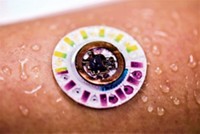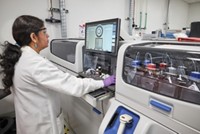Advertisement
Grab your lab coat. Let's get started
Welcome!
Welcome!
Create an account below to get 6 C&EN articles per month, receive newsletters and more - all free.
It seems this is your first time logging in online. Please enter the following information to continue.
As an ACS member you automatically get access to this site. All we need is few more details to create your reading experience.
Not you? Sign in with a different account.
Not you? Sign in with a different account.
ERROR 1
ERROR 1
ERROR 2
ERROR 2
ERROR 2
ERROR 2
ERROR 2
Password and Confirm password must match.
If you have an ACS member number, please enter it here so we can link this account to your membership. (optional)
ERROR 2
ACS values your privacy. By submitting your information, you are gaining access to C&EN and subscribing to our weekly newsletter. We use the information you provide to make your reading experience better, and we will never sell your data to third party members.
Business
Weight To Exhale
Start-up firm develops Dow gas-sensor technology to help monitor weight loss
by Marc S. Reisch
January 28, 2008
| A version of this story appeared in
Volume 86, Issue 4

DIAGNOSTIC DEVICES are not just for laboratories anymore. Pharmacies sell relatively inexpensive devices that allow consumers to monitor their blood pressure. Diabetics can buy simple handheld testers to monitor their blood glucose levels. And soon people concerned about their weight may be able to monitor fat loss with an over-the-counter device based on technology from Dow Chemical.
Start-up firm Kemeta has taken the Dow technology and developed a palm-sized unit, soon to undergo clinical testing, that may allow overweight people to gauge by-products of fat breakdown in their breath. According to the American Obesity Association, about 127 million adults in the U.S. are overweight or obese. Capitalizing on the availability of inexpensive miniature electronic components, the Phoenix-based firm hopes to have a consumer device ready for sale early next year for less than $100.
"Our tool uses an electrochemical sensor system, similar to what's used in a blood glucose monitor, to measure acetone, a known biomarker for fat metabolism, in a person's breath," explains Joan Vrtis, Kemeta's president and chief executive officer. A user blows into a disposable cartridge placed in the analyzer and then reads a "fat burn number" between zero and nine in a display window.
A chart on the device will help the user interpret the readout, Vrtis says. A zero reading corresponds with little to no fat burning detected. A reading between one and three means the user is burning fat at a rate of less than 1 lb per week. Higher readouts correspond to a higher rate. The firm also plans to introduce a device for physicians that will give acetone readouts in parts per million.
It is not unusual for Dow to discover technologies in its labs that don't fit with any of its existing businesses, a company spokesman explains. The firm originally developed the know-how at the heart of the Kemeta tool in the 1990s as part of its exploration of the health diagnostics field.
The technology sat on the shelf until 2005 when Dow offered it to a private technology development firm, RoseStreet Labs, where Vrtis was chief technology officer. A polymer engineer with a Ph.D. from the University of Massachusetts, Vrtis had worked at General Motors and Intel but says she always wanted to "try hard to build something small and challenging." She got her opportunity when RoseStreet spun out Kemeta in 2007.
Dow originally gave RoseStreet a license to the technology in exchange for a 15% royalty on device sales. When RoseStreet spun Kemeta out, Dow agreed to accept a smaller royalty but got a minority stake in Kemeta. Dow declined to provide additional financial details.
In addition to Dow, Vrtis says investors in the firm include herself, RoseStreet Labs, and several individual "angel" investors.
"Unlike the common bathroom scale, Kemeta's device measures fat burn only," Vrtis says, "eliminating the influence of fluid and muscle fluctuation." That provides some comfort to John Hernried, a physician who is president and medical director of the Obesity Treatment Center (OTC) medical group in Sacramento, Calif. OTC treats about 300 patients at any given time, many of whom need to lose 100 lb or more. Hernried is working with Vrtis and Kemeta to develop the device and hopes it will give "positive feedback" to patients who might not always see pounds shed on a scale because their body may be retaining water or gaining lean muscle mass.
OTC will also conduct initial clinical testing required by the Food & Drug Administration. A three-month, two-phase trial soon to get under way will involve 40 patients. The first phase will use the standard gas chromatograph/mass spectrometer test to detect acetone in the breath of patients on OTC's low-calorie diet plan. The second phase will compare GC/MS test results with those from Kemeta's device.
The Kemeta instrument "is potentially a useful device for both us and our patients," Hernried says. It is much simpler to test with the firm's monitor than to collect air samples in a bag for analysis in a GC/MS. The Kemeta device is also portable and will be inexpensive compared with GC/MS, he points out.
FOR A PHYSICIAN, a simple device that measures acetone in a person's breath over time has other advantages too. "Each person's acetone fingerprint is different," Hernried says. If a person's acetone level drops while he or she is on a restricted meal plan, he notes, "we know we need to readjust the diet. Everyone has their own pattern."
Consumers and health care professionals will be able to wirelessly transfer data from the device to a computer to help track the success of diet and exercise programs. "The ability to download information from the device will be very helpful to our staff as they work with individual patients," Hernried says.
Stefan Fritsch, editor of Instrumenta, a U.K.-based newsletter that covers the global analytical instruments market, says Kemeta's device fits the dual trends in the instrumentation business toward product miniaturization and tools to advance personalized medicine.
Amused by the thought that Kemeta could bring a high-tech fat measurement tool to the market, Fritsch notes that advances in electronics have made all manner of lab and industrial sensors inexpensive. "Why shouldn't they take the leap into consumer products?" he asks. If all goes according to plan, Kemeta will be testing the consumer market at this time next year.





Join the conversation
Contact the reporter
Submit a Letter to the Editor for publication
Engage with us on Twitter